Farmhouse style homes allow you to fully embrace the rustic charm with their use of natural materials and cozy design. You’ll appreciate how reclaimed wood, vintage furniture, and warm color palettes create welcoming spaces. The incorporation of natural fibers and stone accents adds authenticity and promotes sustainability. Open floor plans encourage connectivity and optimize natural light, giving your home a roomy feel. It’s simple to add vintage touches for character, such as farmhouse sinks and open shelving for functionality. Learn more about achieving this charming style and personalizing it as you delve deeper.
Key Takeaways
- Farmhouse style homes blend rustic simplicity with functional design, showcasing natural materials like reclaimed wood and stone accents for authenticity.
- Earthy color palettes featuring soft browns, muted greens, and warm whites create a cozy, inviting atmosphere throughout the home.
- Vintage elements, such as antique furniture and reclaimed materials, enhance the charm and storytelling aspects of farmhouse decor.
- Open floor plans promote natural light and seamless movement, combining modern finishes with traditional materials for a warm, welcoming feel.
The Essence of Farmhouse Style
Farmhouse style's charm lies in its blend of rustic simplicity and functional design, creating inviting spaces that feel both authentic and warm. At its core, this style emphasizes rustic elements that connect you to nature and the countryside.
You'll often find earthy color palettes, featuring soft browns, muted greens, and warm whites, which enhance the cozy atmosphere.
Reclaimed materials play a significant role in farmhouse design. Whether it's reclaimed wood beams or vintage barn doors, these features not only add character but also tell a story of sustainability. By incorporating these elements, you create a home that feels lived-in and genuine.
In your living spaces, consider adding vintage accents, like antique furniture or decorative items, to foster that nostalgic touch. These details contribute to an inviting atmosphere that welcomes friends and family.
The essence of farmhouse style is about blending the old with the new, making each room feel both comfortable and functional. Embracing this style allows you to cultivate a serene and warm environment that reflects your love for rustic charm and simplicity.
Key Features of Rustic Homes
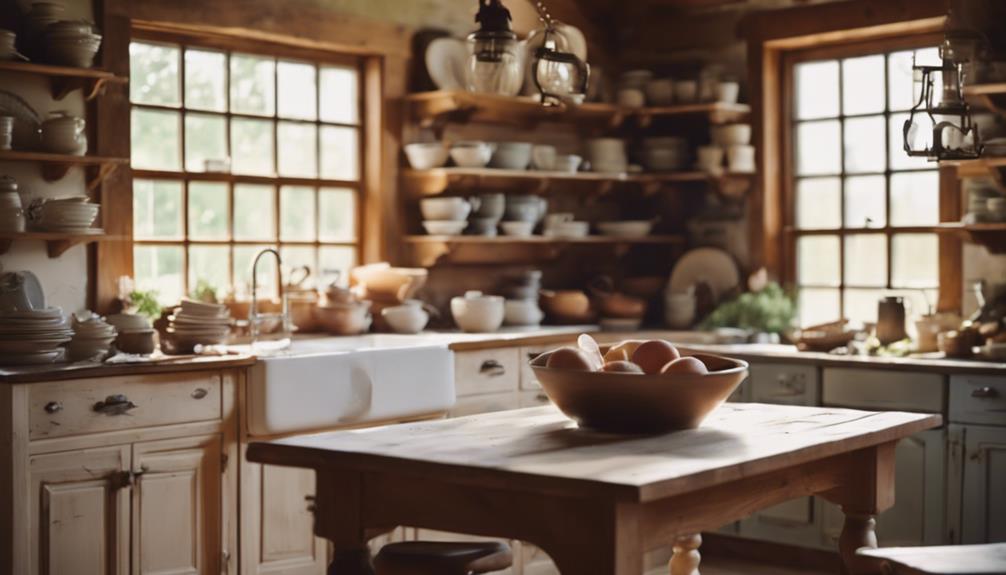
When you think about rustic homes, natural materials play a huge role in creating that authentic feel.
Warm color palettes, with earthy tones and soft whites, help to establish a cozy atmosphere that invites you in.
Together, these elements form the foundation of a rustic aesthetic that many homeowners cherish.
Natural Materials Usage
Natural materials like reclaimed wood and stone create an authentic warmth that defines rustic home design. By embracing these elements, you'll cultivate a cozy atmosphere that invites comfort and connection to nature.
Here are four key components to contemplate:
- Reclaimed Wood: Use it for beams, floors, and furniture to showcase history and craftsmanship.
- Natural Fibers: Incorporate textiles like jute, linen, and cotton for a tactile experience that enhances comfort.
- Stone Accents: Add stone elements in your fireplace or walls to ground the space with earthy tones and texture.
- Vintage Furniture: Choose pieces that tell a story, blending seamlessly with your rustic aesthetic.
The strategic use of these natural materials not only reinforces the farmhouse's character but also promotes sustainability.
As you design your space, remember that each element contributes to a narrative of warmth and authenticity. Embracing these materials guarantees that your home feels inviting while celebrating the beauty of simplicity.
Warm Color Palettes
Embracing warm color palettes in rustic homes instantly creates a cozy and inviting atmosphere that reflects the beauty of the surrounding landscape. You'll often find earthy tones like browns, terracotta, and muted greens dominating these spaces, establishing a harmonious connection with nature. Soft whites and creamy neutrals enhance natural light, making your rooms feel airy while still maintaining that warm vibe you crave.
To add depth and visual interest, consider layering these warm shades with varied textures. Incorporate woven fabrics, distressed wood finishes, and natural materials to enrich the overall design. Accent colors inspired by local flora, such as deep greens or soft blues, can be introduced sparingly to create focal points without overwhelming the rustic charm.
For a touch of nostalgia, don't shy away from using bold colors like rich burgundies or burnt oranges in small doses. These shades evoke a sense of warmth reminiscent of traditional farmhouse aesthetics. By thoughtfully combining warm color palettes with earthy tones and accent colors, you can craft a space that truly embodies the rustic charm of farmhouse style.
Color Palettes for Farmhouse Decor

When choosing colors for your farmhouse decor, consider earthy tones that bring warmth and serenity to your space.
Soft neutrals and whites enhance natural light, creating an airy feel that complements rustic elements.
You can also add bold accent colors to make statement pieces that elevate the overall design without losing that cozy farmhouse charm.
Earthy Tone Combinations
Earthy tone combinations bring warmth and tranquility to farmhouse decor, making your space feel inviting and grounded. By thoughtfully selecting your colors, you can enhance the rustic charm that defines this style.
Here are four ways to incorporate earthy colors into your decor:
- Soft Browns: Use shades of brown to create a warm base, reflecting natural materials like wood.
- Muted Greens: Integrate muted greens, such as sage, to evoke the serenity of nature.
- Warm Creams: Employ warm creams as neutral tones that enhance natural light and create a calming backdrop.
- Terracotta Accents: Add depth with terracotta and burnt sienna for a touch of warmth, reminiscent of traditional farmhouse elements.
Soft Neutrals and Whites
Soft neutrals and whites create a soothing foundation for farmhouse decor, allowing the beauty of other design elements to truly shine. By incorporating soft neutrals like taupe, beige, and soft grays alongside crisp whites, you enhance the rustic charm that defines farmhouse style. This combination fosters a warm, inviting atmosphere while promoting tranquility in your space.
Using a monochromatic palette of whites and creams can maximize natural light, making your rooms feel more spacious and airy. This is especially beneficial in areas where light is limited. You can also add subtle interest by including muted colors like sage green or dusty blue, which complement the primarily neutral palette without overwhelming it.
Layering various textures—think linen, cotton, and distressed wood—within your soft neutral color scheme adds depth and character to your interiors. This not only enhances the aesthetic but also creates a tactile experience that invites interaction. By embracing soft neutrals and whites, you'll cultivate a serene environment that beautifully showcases the rustic charm of your farmhouse home.
Bold Accent Colors
Bold accent colors can transform your farmhouse decor by creating striking focal points that enhance the space's rustic charm. When you incorporate these hues thoughtfully, they can energize your home while maintaining that cozy feel.
Here are four ways to make bold colors work for you:
- Select Deep Hues: Use deep blues or rich greens in accent pieces like throw pillows or artwork to add depth.
- Create Balance: Pair bold colors with a neutral color palette of whites and creams to keep the atmosphere inviting and warm.
- Emphasize Features: Highlight architectural details like exposed beams or shiplap walls with vibrant colors to enhance their character.
- Connect with Nature: Choose accent colors that reflect local flora and fauna, creating a harmonious connection between your interior and the outdoors.
Incorporating Vintage Elements
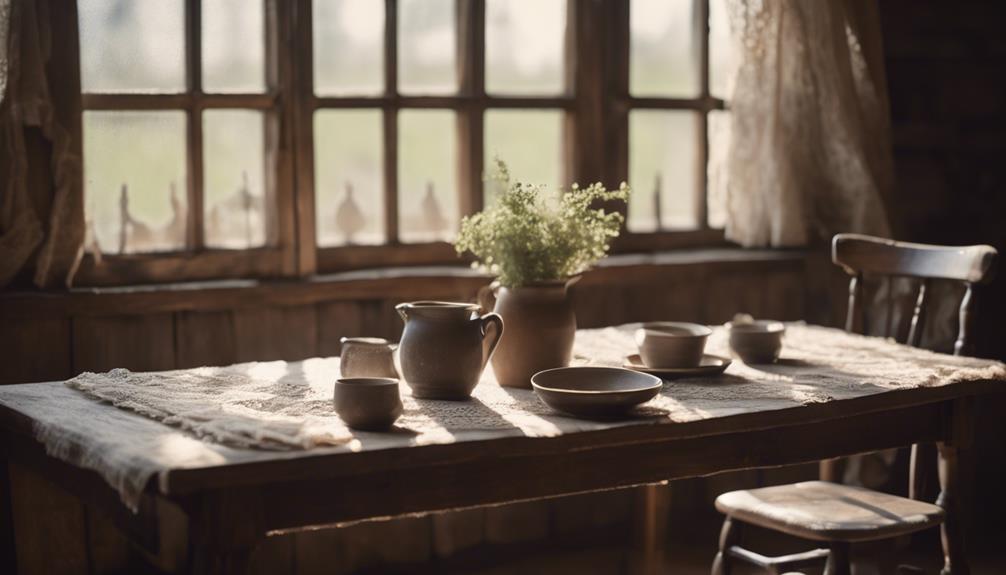
Incorporating vintage elements into your farmhouse style home instantly adds authenticity and character, creating a nostalgic ambiance that feels both inviting and personal. By integrating antique furniture, you not only enhance the rustic charm but also tell a story through each piece.
Look for reclaimed materials, like barn wood or old metal, which can be used in furniture or decor to reinforce the farmhouse aesthetic.
Consider adding vintage lighting fixtures, such as wrought iron chandeliers or glass pendants, to illuminate your space while keeping it cozy. Open shelving in the kitchen is another great way to display vintage dishware or collectibles, maximizing storage while showcasing your personal history.
Don't shy away from repurposing items, either. Transforming an old door into a table or headboard exemplifies creativity and sustainability, adding uniqueness to your home.
Vintage accents like old signage or distressed finishes can serve as conversation starters, enriching your overall decor. By thoughtfully incorporating these elements, you'll create a warm, inviting atmosphere that reflects your personality and love for rustic charm.
Modern Farmhouse Design Trends

When you think about modern farmhouse design trends, open floor plans and neutral color palettes are key elements that stand out.
These features create a spacious and inviting atmosphere, perfect for today's families.
Open Floor Plans
Open floor plans in modern farmhouse designs create a harmonious flow between living areas, kitchens, and dining spaces, promoting both spaciousness and flexibility. These layouts not only enhance natural light with large windows but also foster a cozy atmosphere that invites interaction.
Here are four key benefits of adopting open floor plans in your modern farmhouse:
- Seamless Movement: Enjoy effortless shifts between spaces, making it easier to entertain guests or keep an eye on family activities.
- Natural Light: The incorporation of large windows allows sunlight to flood the interiors, creating an uplifting environment.
- Visual Interest: Combining natural materials like wood and stone with contemporary finishes adds depth and character to your home.
- Multi-functional Spaces: Utilize furniture that serves multiple purposes, maximizing utility while maintaining a warm and inviting feel.
Neutral Color Palettes
Neutral color palettes create a calming backdrop in modern farmhouse designs, allowing the rustic elements to truly shine. You'll find shades like whites, creams, and soft grays providing a serene atmosphere that feels inviting and spacious. These muted tones are inspired by nature, which helps maximize natural light in your home.
Incorporating earthy tones alongside neutrals adds warmth while maintaining the understated elegance that farmhouse style is known for. This combination enhances the charm of your space without overwhelming it. The versatility of neutral colors makes it easy to adapt your decor for different seasons or styles, ensuring your farmhouse remains timeless.
If you want to add a touch of visual interest, consider introducing accents in bolder colors. Just a few carefully chosen pieces can elevate the overall aesthetic without detracting from the soothing effect of your neutral palette.
Ultimately, embracing neutral colors in your farmhouse allows you to create a perfect balance between rustic charm and modern sophistication, making your home feel both cozy and elegant.
Outdoor Spaces and Farmhouse Charm
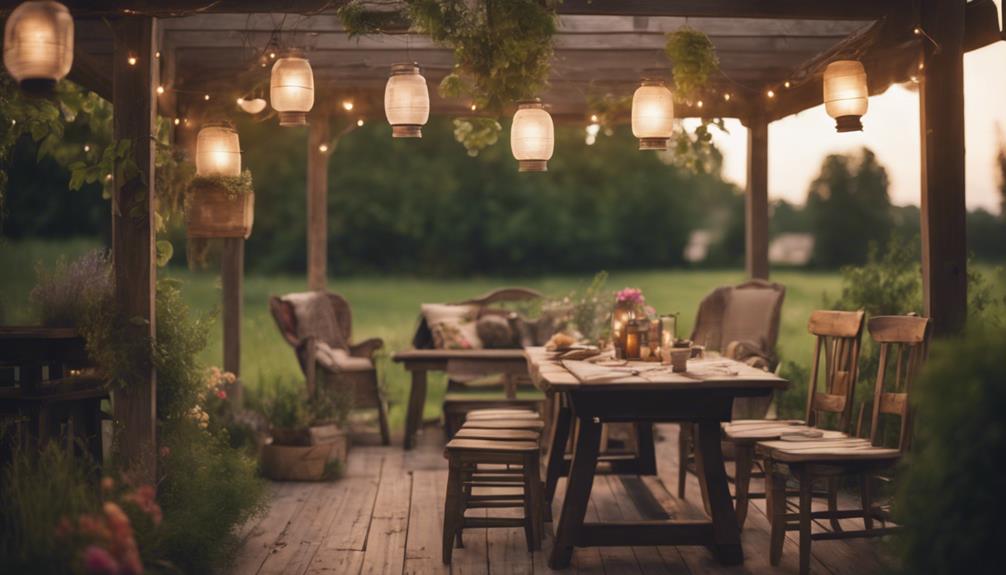
Outdoor spaces in farmhouse-style homes blend rustic charm with functionality, creating inviting areas for relaxation and entertainment. You can enhance your outdoor experience by incorporating elements that reflect farmhouse designs and utilize natural materials. Here are four ways to embrace this charm:
- Patios and Decks: Expanding your outdoor spaces with patios or decks allows for seamless connections between indoor and outdoor living.
- Native Plants: Landscaping with native plants not only beautifies your space but also supports local biodiversity and sustainability.
- Rustic Outdoor Furniture: Choose outdoor furniture that echoes farmhouse charm, favoring durable materials like reclaimed wood and wrought iron for an authentic touch.
- Fire Pits: Create a cozy gathering spot with a fire pit, perfect for social interactions and enjoying cool evenings outdoors.
Thoughtful outdoor lighting, such as string lights or lanterns, enhances the ambiance and highlights the rustic charm of your farmhouse exterior.
Creating Cozy Interiors
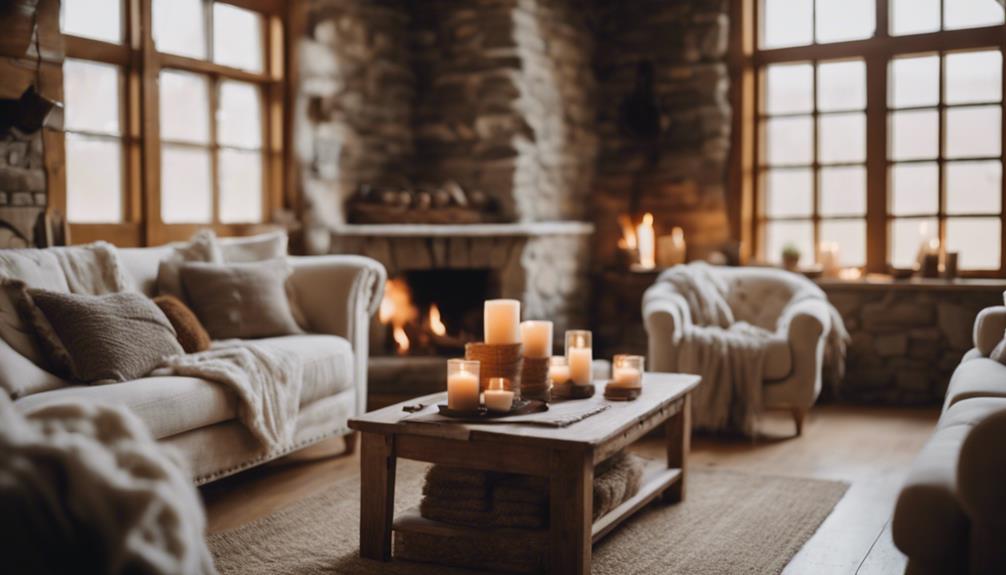
To create cozy interiors in farmhouse-style homes, embrace vintage furniture and layered textiles that add warmth and character to your living spaces. Start by incorporating reclaimed wood tables and antique chairs, which not only provide functionality but also tell a story about the past. Layer soft linens and woven throws on sofas and beds to enhance comfort while inviting relaxation.
Emphasizing natural materials, like stone accents and hardwood floors, gives your interiors a rustic charm that feels both timeless and welcoming. These elements help establish a connection to the outdoors, making your spaces feel grounded and serene.
A neutral color palette dominated by earthy tones and soft whites promotes a calming environment, perfect for cozy interiors. This palette allows you to create a cohesive look while enhancing the beauty of vintage furniture and natural materials.
Don't forget to integrate open shelving; it's a fantastic way to showcase vintage decor and functional items, adding both storage and visual interest. By using these design strategies, you'll craft inviting spaces that embody the essence of farmhouse charm and warmth.
Functional Farmhouse Kitchens
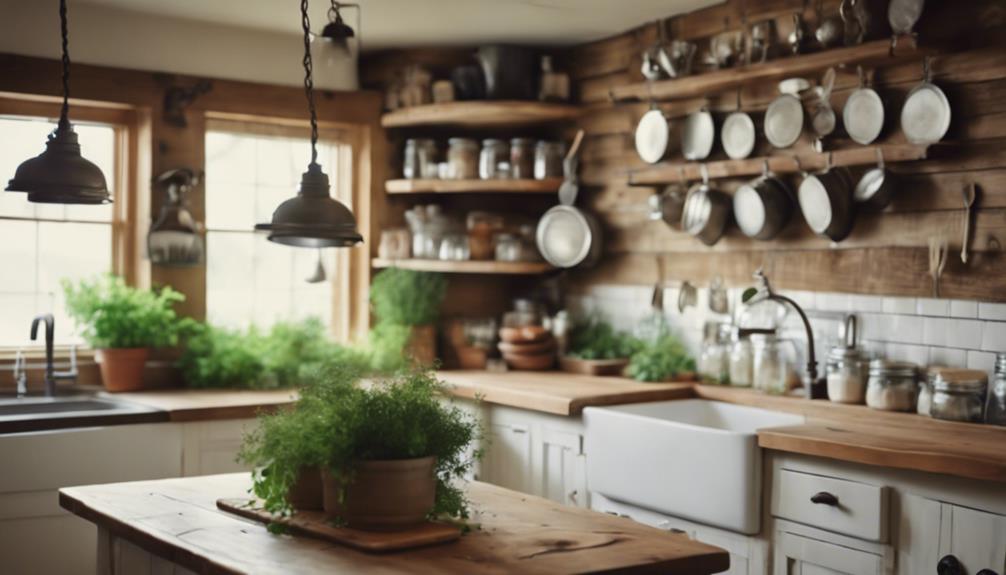
Creating cozy interiors sets the perfect stage for a functional farmhouse kitchen, where open layouts and natural materials come together to enhance both style and practicality.
Here are four key elements to take into account when designing your dream kitchen:
- Large Farmhouse Sink: This iconic feature not only adds rustic charm but also provides ample space for washing large pots and pans, making it ideal for meal prep.
- Open Shelving: Incorporate open shelving to display vintage dishware and rustic decor, merging functionality with aesthetic appeal.
- Natural Materials: Use reclaimed wood for cabinetry and stone countertops to bring warmth and character to your kitchen, emphasizing the farmhouse style.
- Blended Design Elements: Combine modern appliances with traditional touches like exposed beams and distressed finishes, ensuring your kitchen is both functional and stylish.
These elements create a space that's perfect for family gatherings and entertaining guests.
Renovation Tips for Old Farmhouses
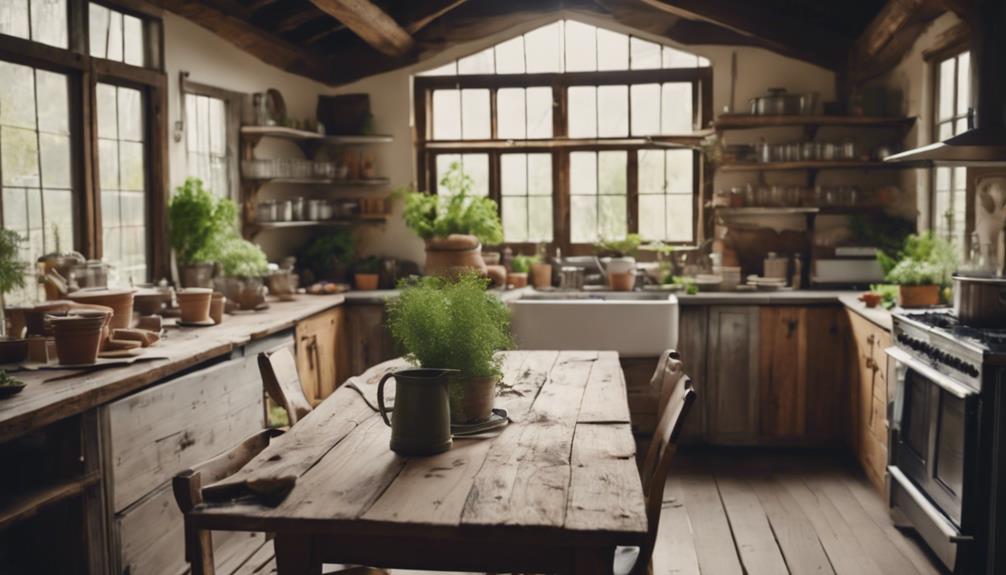
Renovating an old farmhouse can breathe new life into its charming features while preserving its unique character. Start by focusing on the original elements, like exposed beams and wide plank floors, to maintain that timeless charm.
You'll want to incorporate energy-efficient windows and insulation to enhance comfort and lower energy costs, all while respecting the rustic aesthetic.
Consider utilizing reclaimed materials, such as barn wood and antique fixtures, to add character and sustainability to your renovation. These choices not only enhance the home's appeal but also tell a story of the farmhouse's history.
If you're looking to modernize the space, think about creating an open living layout. This approach allows for a spacious and functional design that meets contemporary needs without sacrificing the farmhouse's traditional essence.
Don't forget to prioritize natural light. Enlarging windows or adding skylights can brighten up your space, creating an inviting atmosphere that's typical of farmhouse homes.
Embracing Sustainability in Design
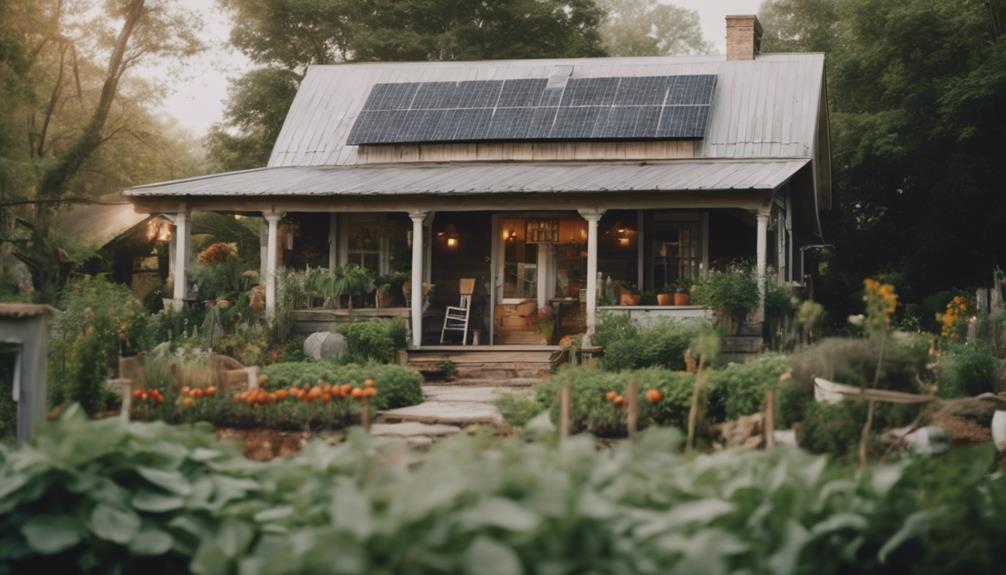
Embracing sustainability in design not only enhances the appeal of farmhouse homes but also aligns with modern values that prioritize environmental responsibility.
Here are a few ways you can incorporate sustainable practices into your farmhouse design:
- Use reclaimed materials: They add character and reduce landfill waste, promoting eco-friendliness in construction.
- Incorporate natural materials: Opt for non-toxic choices like FSC certified woods and low-VOC finishes to improve indoor air quality.
- Choose sustainable furniture: Look for solutions that minimize hardware and increase durability, reducing environmental impact.
- Source locally: By utilizing locally sourced materials, you support regional economies and cut down on transportation-related carbon footprints.
Frequently Asked Questions
What Decor Is Replacing Farmhouse?
You're seeing minimalist designs like Scandinavian and Japandi styles replace farmhouse decor. Bold colors and sustainable materials are trending, along with industrial elements and smart technology, creating a modern aesthetic that's functional and stylish.
What Is the Difference Between Rustic and Farmhouse Style?
Imagine a lumberjack choosing between cozy flannels and tailored shirts. Rustic style leans towards raw materials and rugged charm, while farmhouse style blends those elements with a polished, functional feel, emphasizing comfort and livability.
What Is Rustic Farmhouse Decor?
Rustic farmhouse decor combines natural materials like reclaimed wood and stone with a neutral color palette. You'll find vintage accents, distressed finishes, and layered textures that create a warm, inviting atmosphere full of character and charm.
How Do You Style a Rustic Farmhouse?
To style a rustic farmhouse, mix textures like burlap and wood, weave in vintage finds, and layer earth-toned textiles. You'll create a cozy atmosphere that feels like a warm hug from nature itself.
How Can I Incorporate Farmhouse Style into my Workspace with a Farmhouse Desk?
Transforming your workspace with a rustic farmhouse desk solution is easier than you think. Add wooden shelves, vintage mason jars as storage, a distressed rug, and a cozy chair. Incorporate natural textures, plants, and neutral colors to complete the farmhouse look. Enjoy a stylish and functional workspace with a farmhouse desk.
Conclusion
Embracing farmhouse style is like wrapping your home in a warm, cozy blanket of rustic charm!
With its enchanting features and vintage flair, your space can transform into a picturesque haven.
You'll feel like you've stepped into a storybook every time you walk through the door.
So go ahead, immerse yourself in those earthy tones and charming details, and watch your home come alive.
Who knew creating a peaceful retreat could be this exciting?
It's pure magic!






